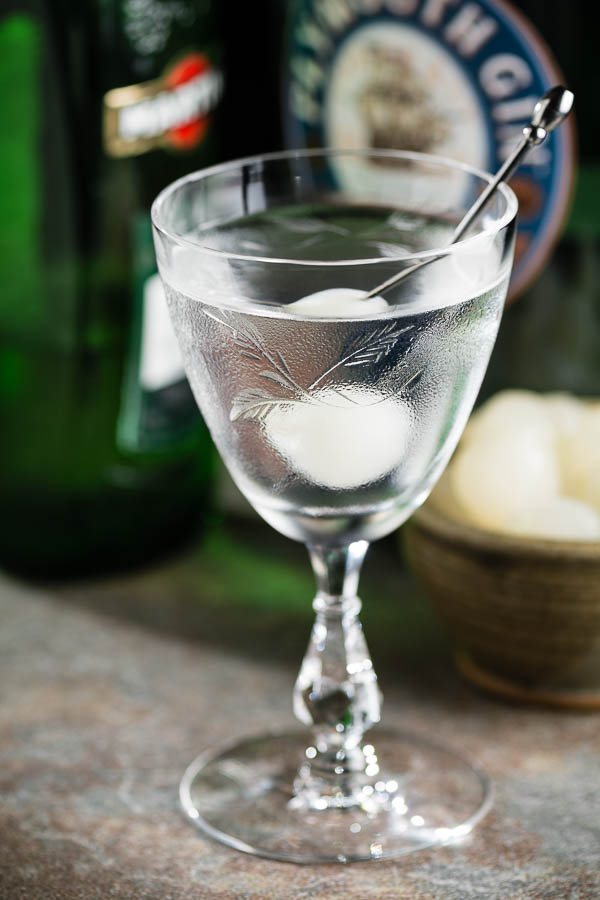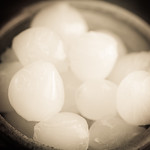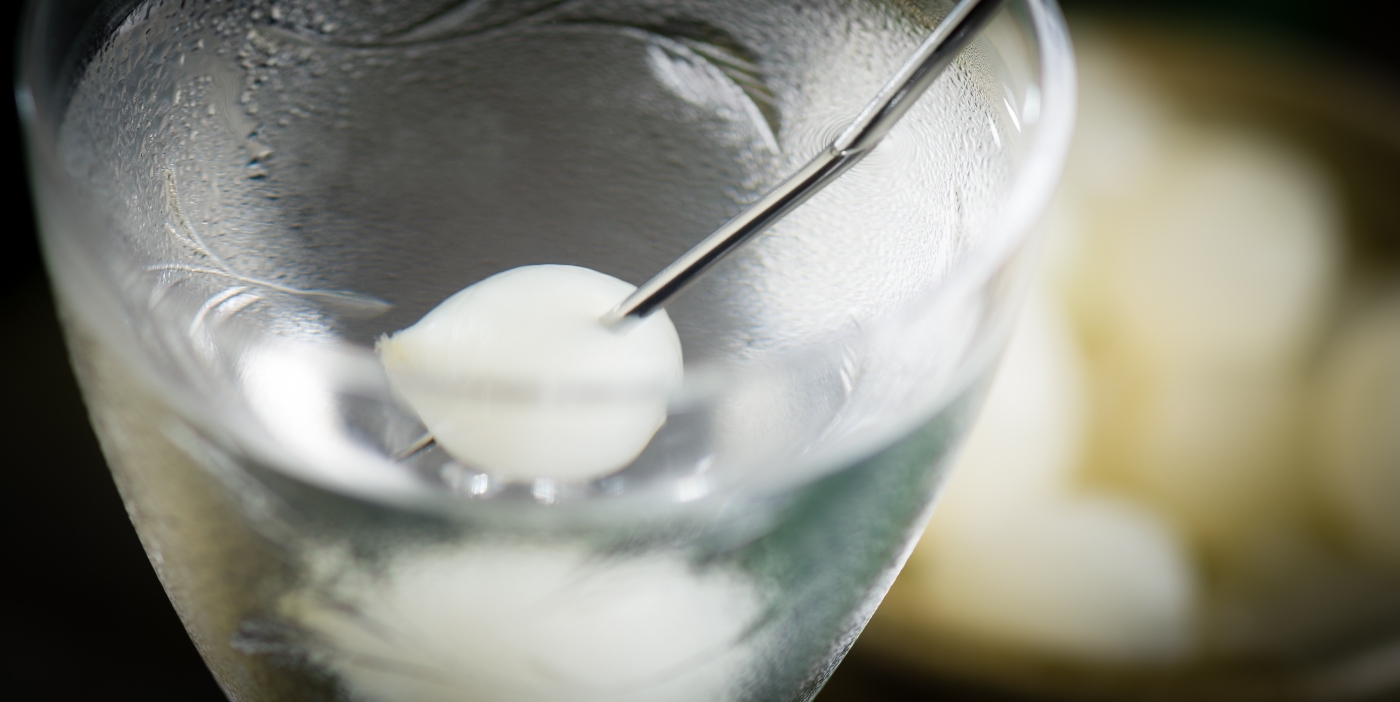Steward: “Cocktail before dinner?”
Thornhill: “Yes, I’ll have a Gibson.”
So begins one of Alfred Hitchcock’s most amusing scenes, the famous club car seduction scene between Cary Grant’s Roger Thornhill and Eva Marie Saint’s Eve Kendall in North by Northwest. Seduction isn’t really the right word; it’s more of a pickup scene between two people who don’t seem to be in the habit of resisting. Grant’s Thornhill seems the type to always have his motor running; clearly, it’s Eve who’s shifting the gears.
The Gibson Cocktail also fuels a plastered Margo Channing in All About Eve. Bette Davis’s Margo describes herself as a “Gibson Girl;” her drink’s starring scene is at the party that inspires Davis’s immortal line, “Fasten your seatbelts, it’s going to be a bumpy night.”
Two great Hollywood movies—that’s a pretty good record for a Martini with an onion in it.
Except that it isn’t that simple. In fact, history tells us that the Gibson is absolutely not a Martini with an onion in it. Close, but no.
The History of the Gibson Cocktail
For starters, it turns out that the original Gibson probably did not have an onion garnish. That particular bit of presentation— now considered the hallmark of the Gibson— isn’t listed in any early recipes, and apparently doesn’t show up until the 1920s.
Even more to the point is the lack of bitters, which were always present in the Martinis of the classic era. The earliest published formula for the Gibson is from William Boothby’s 1908 The World’s Drinks and How to Mix Them, and Boothby was adamant that the Gibson contain no bitters, annotating his recipe, “Note.—No bitters should ever be used in making this drink, but an olive is sometimes added.”
As for the actual origins of the Gibson, that’s where the fun really starts. Just as with the Martini and many other simple cocktails, there are lots of origin stories, each attaching fame and glory to one Gibson or another.
There are origin stories from Paris, London, New York, Chicago, and San Francisco. In one of the stories, the Gibsons (there are two of them) are actually young ladies. Barnaby Conrad III, in The Martini, tells this story:
…Steve Zell at the Occidental Grill in San Francisco says the name came out of Chicago. “You’ll notice that Gibsons are usually served with two skewered onions. I heard that during the twenties in Chicago there were twin sisters named Gibson who loved Martinis but hated olives. Whenever they’d go out, they’d get the bartenders to use two pickled onions—twins for twins.
Cute story. As bogus as they come, but cute.
Two of the origin stories actually have a chance at being (sort of) true. The one that’s been most circulated until recently is that the drink is named after Charles Dana Gibson, the famous New York advertising illustrator who invented the Gibson Girl. The gist of the story is that Gibson was at the Player’s Club in New York, and challenged the bartender, Charley Connolly, to make him a better Martini. Connolly plopped an onion in his standard Martini, called it the “Gibson,” and that was that.

The story that seems to have gained traction recently among people who study these things posits that the Gibson Cocktail was first poured at San Francisco’s Bohemian Club sometime in the 1890s. The namesake Gibson in this story is a Walter D. K. Gibson, apparently a successful local businessman. According to Eric Felton’s research, the credence of this version is supported by an 1898 reference to the drink, which appears to be the first in print.
Making the Gibson
Whatever its origin, the Gibson is one of the simplest of cocktails, even simpler than the venerable Martini to which it is often compared.
The Gibson Cocktail
- 2 oz London Dry Gin (Bombay Dry, Beefeater 24)
- 1 oz dry vermouth (M&R Dry)
- 1 or 2 pickled cocktail onions for garnish
Stir the gin and vermouth with ice until very cold; strain into a chilled cocktail stem. Garnish with onion.
Early published recipes call for equal parts of gin and vermouth. I’ve seen some commentary suggesting that the original was actually much drier than the published formulas state, but I’ve never seen anything to support that. I do prefer to make the Gibson at about 2:1 or 3:1. I also recommend the classic London Dry gins like Beefeater and Bombay Dry; they both blend well with the savory nose and flavor of the onion.
 The onion itself can be a difficult customer. The typical grocery store cocktail onion is a sharp, rather harsh item; it makes a nice-looking decoration in the drink, but doesn’t help the flavor of your drink, and is unpleasant to eat by itself, unless you have a particular taste for preservatives and vinegar.
The onion itself can be a difficult customer. The typical grocery store cocktail onion is a sharp, rather harsh item; it makes a nice-looking decoration in the drink, but doesn’t help the flavor of your drink, and is unpleasant to eat by itself, unless you have a particular taste for preservatives and vinegar.
Fortunately, the web is full of good recipes for cocktail onions. They’re quick and easy to make (for anyone who can boil water), and the result is both gratifying and delicious.
Gin, vermouth, onion: that is the Gibson. Simple, cold, clean, crisp, and urbane.
“Chasing the Gibson Cocktail” at cold-glass.com : All text and photos © 2016 Douglas M. Ford. All rights reserved.

Excellent post! Good to learn about this deceptively simple drink.
Thank you, Gordon.
>
Great history! I love Gibsons and far prefer them to Martinis, but never knew their origins. I think I just like gin better than vodka, and the vermouth, in my opinion, sets off gin far better than it does vodka. And I always thought the pearl onion was just for show, so it was nice to read about where it actually came from. Your photos are beautiful, too. If it wasn’t 9:00 a.m. on a Sunday morning where I am, I might be tempted to whip one up. :) Lovely post.
I agree, the Gibson doesn’t really come across as a brunch cocktail. I’m glad you enjoyed the post, thanks!
Am curious — what will you be drinking on election night?
Interesting question. Odds are good I’ll start with a Martini (or Gibson), and end with bourbon on ice. As for what goes in between, I’m looking forward to finding out.
LOL. I am still trying to figure out how to start. Haven’t even gotten to thinking about how to end. All I know is that a Ward 8 will be somewhere in the mix. Depending on what goes on during the day/evening, a Dark and Stormy may also make an appearance.
Dark and Stormy, that’s amusing. And probably appropriate, no matter what happens.
Thanks for rood read, Doug! As always the story is amazing :)
Being flooded with Martinis (I hope it is right using of these words) for a couple of past years I try to understand Gibson again. In a matter of fact I have tried Gibson some times before and found it … disgusting. That onion smell in the finish. Pah! Not for me :) But after I tasted Opihr and heard about horseradish notes in palate of Thomas Dakin … I am thinking about to give to Gibson yet one chance :)
(by the way, my favorite fable about Gibson by now is a story about Hugh Simons Gibson who used onions as a sort of mark (and, I suppose, a guarantee from being debunked :) for his fake Martini.)
rood = good
I was hoping that…
I know what you mean about the smell of the onion at the bottom of the drink. I think there’s a real difference in onions, with the heavily-pickled commercial ones being the biggest offenders. I have had better luck with onions I’ve prepared myself, perhaps because they’re fresher, and a bit less full of vinegar. But in the end, if you don’t like it, then that’s something good to know.
By the way, I’ve been enjoying your Martini series at Instagram, thanks for that!
“Boothby was adamant that the Gibson contain no bitters, annotating his recipe, “Note.—No bitters should ever be used in making this drink, but an olive is sometimes added.”
Excuse me, but…I could’ve SWORN there was this drink that contains gin and vermouth, is stirred, and has an olive in it. I could be wrong, but…there’s this niggling idea that I’m not.
It suggests that Boothby was an adamant Martinis-must-have-bitters guy. In the modern age, where the bitters seem to be generally omitted from Martinis, there is little distinction between Boothby’s Gibson-with-olive and the average bar’s Martini-with-olive. In Boothby’s day, it seems to that a bitters-free Martini was such a departure as to call for an entirely new name for the drink. At least, that’s my reading of the evolution of the two recipes.
Could be, I suppose. The first time I know something that we’d recognize as a Martini, and under that name, it’s in Harry’s ABC, where the bitter is mentioned, but is optional. So, not at all impossible indeed.
An old friend once told me that a Gibson onion was used as a signal at a diplomatic affair to differentiate between a drink containing alcohol and one that did not. Any truth to this or is it just urban legend?
There is no shortage of origin stories for this drink. An embellished version of the diplomacy-themed story has it being about an American ambassador (named Gibson, of course) who, though in London, felt patriotically constrained by Prohibition at cocktail time, so asked that his cocktail glass of water be marked with an onion as the martini tray was passed around.
In the end, no one really seems to know where the truth lies. I’m partial to the bogus attractive sisters story because, well, attractive sisters…